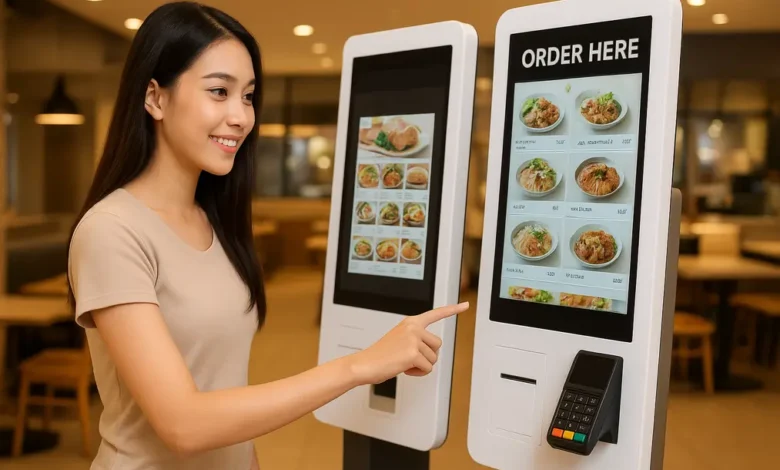Self Ordering System in Thailand – ระบบสั่งออเดอร์สินค้าด้วยตนเองในประเทศไทย: The Future of Smart Dining and Retail

Introduction: Thailand’s Digital Revolution in Ordering Systems
Over the past few years, Thailand has been rapidly transforming into a tech-driven society, and one of the most fascinating examples of this transformation is the self ordering system in Thailand – ระบบสั่งออเดอร์สินค้าด้วยตนเองในประเทศไทย. From local cafes to high-end restaurants, digital kiosks and mobile ordering platforms are changing how people shop, eat, and experience customer service.
This self-service trend is not just about convenience — it’s about redefining customer interaction. Instead of waiting in line or depending solely on human staff, customers now enjoy the freedom to browse, customize, and pay for their orders independently. Whether it’s a food court in Bangkok, a convenience store in Phuket, or a bubble tea shop in Chiang Mai, the self ordering system in Thailand is becoming the new normal.
As Thailand continues to embrace digital innovation under its “Thailand 4.0” initiative, this technology is not only improving business efficiency but also enhancing the overall customer experience.
What Exactly Is the Self Ordering System in Thailand – ระบบสั่งออเดอร์สินค้าด้วยตนเองในประเทศไทย?
In simple terms, a self-ordering system allows customers to place their orders through a digital interface — typically via touchscreen kiosks, tablets, or smartphone applications. The Thai phrase “ระบบสั่งออเดอร์สินค้าด้วยตนเอง” literally means “a system that lets customers order products by themselves.”
In Thailand, these systems have found their way into a wide range of sectors — from restaurants and cafés to retail stores and cinemas. When you walk into a modern McDonald’s or KFC branch in Bangkok, you’ll often see self-service kiosks lined up at the entrance. Customers can browse through digital menus, customize their meals, and pay instantly using e-wallets like TrueMoney, PromptPay, or LINE Pay.
Moreover, small businesses and local restaurants are also joining the movement by using QR-code-based ordering systems. Customers can simply scan a QR code placed on the table, view the digital menu, and order without needing to flag down a waiter. This blend of convenience and digital flexibility defines the self ordering system in Thailand – ระบบสั่งออเดอร์สินค้าด้วยตนเองในประเทศไทย as one of the most practical innovations of the modern era.
Why the Self Ordering System in Thailand Is Growing So Fast
The rapid rise of the self ordering system in Thailand can be traced to three main factors — labor efficiency, contactless convenience, and digital readiness.
1. Labor Efficiency:
Many businesses in Thailand, especially in the hospitality and food sectors, face staffing shortages during peak hours or tourist seasons. By integrating a self-ordering system, restaurants can manage larger crowds with fewer employees. The system reduces human error, speeds up service, and allows staff to focus more on food preparation and customer assistance rather than manual order-taking.
2. Contactless Convenience:
During the COVID-19 pandemic, businesses had to find ways to continue operating while minimizing physical contact. The self ordering system in Thailand – ระบบสั่งออเดอร์สินค้าด้วยตนเองในประเทศไทย proved to be the perfect solution. Customers could place and pay for their orders without handing cash or touching menus that others had used. Even after the pandemic, this contactless culture remains deeply preferred among Thai consumers.
3. Digital Economy & Cashless Push:
Thailand’s government actively promotes digital transformation through its “Smart Thailand” and “Thailand 4.0” initiatives. With the country’s high smartphone penetration and widespread adoption of e-wallets, consumers are ready for digital payment and ordering solutions. The self-ordering system fits perfectly into this vision of a cashless, efficient, and customer-friendly economy.
How the Self Ordering System in Thailand Works
The process behind the self ordering system in Thailand is intuitive and user-friendly, ensuring that anyone — from tech-savvy youth to first-time users — can navigate it effortlessly.
Here’s how it generally works:
- Menu Browsing:
Customers interact with a digital menu displayed on a kiosk or mobile screen. These menus are usually bilingual (Thai and English) and include clear images, descriptions, and prices. - Customization:
Users can easily add or remove ingredients, select portion sizes, and choose combo options. This level of customization helps eliminate confusion and ensures satisfaction. - Payment:
Once the order is finalized, the system allows payment through cash, cards, or mobile wallets like PromptPay, TrueMoney, Rabbit LINE Pay, or even direct bank transfers. - Order Tracking:
After payment, the order is instantly transmitted to the kitchen or product counter. Customers can track their order status on-screen or receive updates via digital number boards or notifications.
This smooth and transparent process saves time, reduces miscommunication, and enhances the customer experience.
Benefits of the Self Ordering System in Thailand – ระบบสั่งออเดอร์สินค้าด้วยตนเองในประเทศไทย
The self ordering system in Thailand offers a win-win situation for both business owners and customers.
For Businesses:
- Increased Efficiency: Digital systems reduce wait times and free up employees for other tasks.
- Higher Sales: The system can automatically recommend add-ons, upgrades, or combos, subtly increasing average order value.
- Data Collection: Businesses can analyze purchase trends, popular products, and customer preferences to make better decisions.
For Customers:
- Faster Service: There’s no waiting for staff — orders go straight to the kitchen or preparation area.
- Personalized Experience: Customers can take their time selecting items without pressure.
- Transparency: Prices, calories, and special promotions are displayed clearly.
Overall, this system promotes a modern, efficient, and customer-first environment, making dining or shopping experiences smoother and more enjoyable.
Challenges and Limitations
Despite the benefits, the self ordering system in Thailand – ระบบสั่งออเดอร์สินค้าด้วยตนเองในประเทศไทย still faces certain challenges.
1. Initial Investment:
Installing kiosks, setting up digital infrastructure, and maintaining software can be expensive for small businesses. While larger corporations can absorb these costs, smaller restaurants might hesitate to invest.
2. Technical Maintenance:
System crashes, slow internet, or outdated software can cause disruptions. Businesses must ensure proper technical support and maintenance to avoid downtime.
3. Customer Adaptation:
Although Thai consumers are increasingly tech-savvy, older generations and those in rural areas might still prefer traditional ordering methods. Therefore, hybrid systems — a mix of digital and human service — remain essential during the transition phase.
Nonetheless, as more people become familiar with smartphones and digital payment apps, these challenges are gradually diminishing.
The Rise of QR Code and Mobile Ordering Systems
One of the most innovative and affordable forms of self-ordering technology in Thailand is QR code ordering. Instead of investing in costly kiosks, restaurants can simply print QR codes and place them on tables or counters.
Customers scan the code with their phone camera, access the digital menu, place their order, and pay — all within minutes. This method has gained massive popularity among small cafés, street food vendors, and even hotel restaurants.
The self ordering system in Thailand – ระบบสั่งออเดอร์สินค้าด้วยตนเองในประเทศไทย has therefore evolved beyond hardware kiosks into mobile-first solutions that are easy to deploy and maintain. With the help of popular apps like LINE MAN, Robinhood, and Foodpanda, businesses can integrate online and offline operations seamlessly.
Impact on Thailand’s Economy and Workforce
The widespread adoption of the self ordering system in Thailand has ripple effects across the economy.
Firstly, it encourages digital literacy among consumers and business owners alike. As more Thais get comfortable with digital menus and payments, the country’s transition toward a fully digital economy becomes smoother.
Secondly, rather than replacing human jobs, the system is reshaping roles. Employees are now trained to manage systems, troubleshoot technical issues, and focus more on hospitality rather than manual tasks. This evolution improves service quality and creates opportunities in tech support and digital operations.
Thirdly, the integration of these systems supports Thailand’s growing startup ecosystem. Local tech companies are developing new ordering platforms, offering affordable solutions for SMEs (small and medium enterprises) nationwide.
Future of Self Ordering System in Thailand – ระบบสั่งออเดอร์สินค้าด้วยตนเองในประเทศไทย
The future of self-ordering systems in Thailand looks incredibly promising. With the rise of AI, machine learning, and voice ordering technology, customers can soon expect even more intuitive and personalized experiences.
Imagine a kiosk that remembers your favorite drink or a mobile app that suggests lunch options based on your previous orders. These innovations are not far away — they are already being tested by forward-thinking Thai businesses.
Additionally, the integration of robotics in food preparation and digital delivery systems could create a fully automated service ecosystem. The continued push toward a cashless society will further cement the role of ระบบสั่งออเดอร์สินค้าด้วยตนเองในประเทศไทย as a key component of modern business.
Conclusion: Thailand’s Journey Toward Digital Convenience
In conclusion, the self ordering system in Thailand – ระบบสั่งออเดอร์สินค้าด้วยตนเองในประเทศไทย is not just a passing trend — it’s a revolution that represents Thailand’s commitment to innovation, convenience, and efficiency.
For businesses, it offers operational control and scalability. For customers, it provides speed, flexibility, and transparency. And for the Thai economy, it marks another step toward becoming a smart, tech-driven nation ready for the future.
From bustling cities to small-town cafés, this system is changing how people order, pay, and experience service. As Thailand continues to evolve digitally, the self-ordering culture will undoubtedly become an integral part of daily life — redefining the meaning of convenience for years to come.



